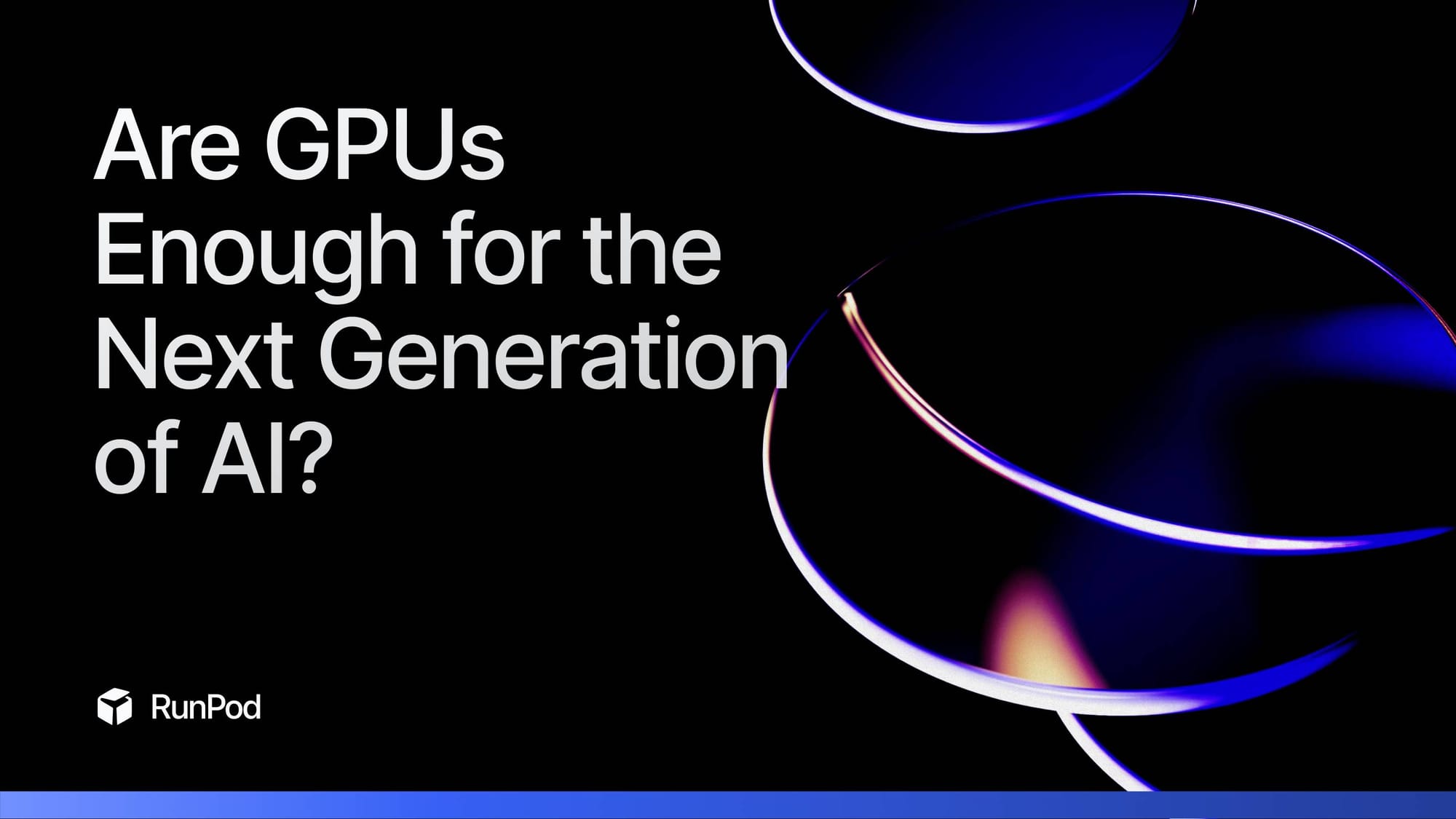The Future of AI Training: Are GPUs Enough for the Next Generation of AI?
AI workloads are evolving fast. GPUs still dominate training in 2025, but emerging hardware and hybrid infrastructure are reshaping the future. Here’s what GTC 2025 reveals—and how RunPod fits in.

Once upon a time, a few good GPUs and a clever model were all it took to train something impressive. Now? We’re wrangling trillion-token datasets, juggling multi-modal inputs, and praying our thousand-GPU clusters don’t melt through the data center floor. AI has leveled up—and it’s dragging our infrastructure along for the ride.
NVIDIA’s GTC 2025 keynote felt less like a flex and more like a shift. Blackwell Ultra pushes the limits of GPU performance—but Grace is the quiet revolution. The future of AI training won’t be built on brute force alone. It’ll be a choreography between CPUs and GPUs, precision and scale.
The State of AI Training Today
Right now, GPUs dominate the AI training landscape. From H100s powering large-scale commercial workloads to 4090s enabling small teams to train and iterate locally, GPUs have made deep learning broadly accessible. Multi-node clusters are the standard for scaling massive models, and platforms like RunPod make it easy to train across multiple GPUs without managing physical infrastructure.
The maturity of CUDA, widespread support from every major AI framework, and steady improvements in performance have created an ecosystem that’s incredibly powerful—and difficult to beat.
But even as the tooling gets better, the demands of modern AI are pushing the limits of what GPUs can handle.
What’s Changing in AI Workloads?
The scale and complexity of AI models have exploded in recent years. Foundation models like GPT-4, Gemini, and Claude 3 are trained on trillions of tokens, spanning multiple modalities—text, images, audio, video—and require months of compute time. Simply stacking more GPUs together still works, but it introduces diminishing returns and steep coordination overhead.
Meanwhile, model architectures are evolving in ways that challenge GPU-dominant compute patterns:
- Mixture of Experts (MoE) selectively activate only parts of a network
- Retrieval-augmented generation (RAG) integrates external data sources into inference
- Sparse attention mechanisms focus computation where it matters most
- Multi-agent systems require coordination between several cooperating models
Some of these patterns thrive on GPU parallelism. Others might benefit from entirely different acceleration strategies.
And it's not just training that’s changing. The broader AI pipeline now spans data preprocessing, fine-tuning, evaluation, and large-scale inference—each with its own set of compute demands. The one-size-fits-all model of AI infrastructure is quickly becoming obsolete.
GTC 2025: Reading Between the Lines
NVIDIA’s GTC 2025 announcements reflect this changing reality. The company unveiled:
- Blackwell Ultra, offering a 50% performance boost over the previous generation
- Vera Rubin AI chips, built to support specialized, heterogeneous AI workloads
- A clear vision from CEO Jensen Huang that the future isn’t just faster GPUs—it’s task-specific processors working together
These aren’t just product upgrades. They’re signals that even NVIDIA is building for a post-GPU future.
Are GPUs Still the Smartest Bet?
In the short term? Absolutely. GPUs are still the best option for most AI training tasks. They're well-supported, easy to scale with modern frameworks, and familiar to the engineers using them. And with architectures like Blackwell Ultra delivering substantial generational improvements, there's still plenty of runway.
But cracks are beginning to show. Supply remains tight for the latest cards. Power and thermal limits are increasingly difficult to work around. And as models continue to scale, the cost of GPU-only infrastructure becomes harder to justify—especially when thousands of units are required just to train a single model.
Meanwhile, alternatives are quietly gaining ground. Google’s TPUs, Graphcore’s IPUs, Cerebras' wafer-scale chips, and even custom ASICs are all being deployed in production for specific workloads. And NVIDIA’s own Vera Rubin chips suggest that even the dominant player sees the value in specialization.
What This Means for AI Teams
For engineers building and deploying models, the takeaway is clear: the future is hybrid. We’re moving toward a world where different parts of the AI pipeline run on different kinds of hardware, each optimized for the task at hand. That might look like:
- Preprocessing data on CPUs
- Training dense core models on GPUs
- Offloading sparse or specialized operations to accelerators
- Deploying inference on low-latency or energy-efficient chips
This shift isn’t just about choosing new chips. It’s about designing infrastructure that can evolve as quickly as the workloads it supports. That means flexible orchestration, modular compute layers, and a mindset that values adaptability over allegiance to any single hardware standard.
How RunPod Fits Into the Future of AI Training
At RunPod, we’re building the infrastructure layer for this new era. Today, we provide on-demand access to high-performance GPUs, bare metal environments for full system-level control, and multi-node deployments for large-scale distributed training.
But we’re also thinking beyond GPUs. As specialized accelerators mature, we’re designing our platform to support them. We're investing in orchestration tooling to help teams manage increasingly complex hybrid environments. And we’re working to help users match their workloads with the best-fit hardware—because efficiency matters, now more than ever.
Whether you're training with a single GPU or deploying a heterogeneous cluster, RunPod is built to support the next generation of AI infrastructure.
The Bottom Line: Are GPUs Enough?
In 2025? Yes. For most teams, GPUs are still the smartest choice.
In 2026 and beyond? Probably not on their own. The future of AI training is more complex, more distributed, and more specialized than ever before. And that’s not a limitation—it’s an opportunity.
With the right infrastructure partner, it's possible to stay ahead of the curve, no matter what shape the next wave of hardware takes.
We’re here to help you build what’s next.
